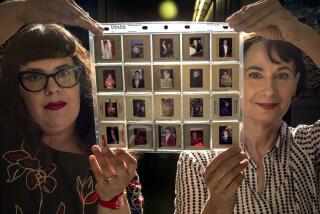The Playboy mind
- Share via
Fifty years ago, Hugh Hefner introduced the first issue of Playboy with the words, “If we are able to give the American male a few extra laughs and a little diversion from the anxieties of the Atomic Age, we’ll feel we’ve justified our existence.”
All in all, Hefner kept his word, delivering abundant female nudity against a background of politics, art, humor and literature to readers who reveled in the magazine’s male libido-driven observations on popular culture.
The “background,” as it turned out, came to encompass a trove of significant voices and images, and as part of its ongoing anniversary festivities, Playboy invited experts from Christie’s into the magazine’s vast New York, Chicago and Los Angeles archives to go through 5,000 works of art, 10,000 photographs and countless manuscripts and put together an auction aimed at selling some of its legacy to its loyal fan base.
When the 311 lots -- including cartoons, rare manuscripts, fine art, photography and memorabilia -- go on the block on Wednesday in New York, they are expected to bring between $1.5 million and $2 million. Though this is nothing to sneeze at, the money is only part of Playboy’s motive for holding the sale. “I thought we could generate a million dollars for the company and reach a million people with the extraordinary story of Playboy and its impact on the world of literature, design, ideas and art,” says Christie Hefner, chairman and CEO of Playboy Enterprises, the founder’s daughter.
“We know we have collectors, so we thought that instead of engaging in private negotiations to sell part of the collection, we would have a public auction, where anyone anywhere can own a piece of Playboy.”
Leaving aside the feminist politics that evolved alongside, and at times in opposition to, Playboy’s evolution -- famously critiqued by feminist Gloria Steinem, who went underground as a Playboy bunny in 1963 -- Playboy’s archives offer a fascinating window onto the magazine’s relationships with a remarkable array of intellectuals and artists who shaped American thought. In fact, the first lot in the sale goes a long way toward expressing Playboy’s unique mix of artistic and intellectual content with sexuality and humor. It is a black-and-white cartoon drawn by Hefner that appeared in the first issue of the magazine. It shows a couple of geeky, grinning male art students staring at an entirely abstract painting. The punch-line, “Man -- is she stacked,” says all we need to know about the Playboy ethos. Playboys live in a world of art and ideas while seeing naked women at every turn.
“We went through a ton of material and selected things that represent the broad cultural base that Playboy is trying to describe,” says Tom Lecky, a Christie’s specialist in manuscripts and rare books who helped assemble the sale. “Playboy was a lifestyle magazine without a specific ideology. There are interviews with Fidel Castro, Arthur C. Clarke, William F. Buckley, Cassius Clay, which were designed to reach a broad audience with a broad range of voices.”
Lecky, along with Francis Wahlgren, dug through Playboy’s to find manuscripts that offer as much to the scholar as to the Playboy fan. These include rare glimpses of the paper trails of handwritten notes, carbon copies and typewritten manuscripts between editor and author that have been all but erased by the dominance of electronic communication. “You can see from the manuscripts,” said Aaron Baker, the magazine’s curator of Playboy art, “that when people said they read Playboy for the articles, they meant it.”
Highlights of the sale include Ian Fleming’s manuscript of “On Her Majesty’s Secret Service,” the precursor to the James Bond series, which shows the author’s thought processes as he prepared his work for its U.S. serialization. It is expected to sell for $18,000 to $24,000. Expected to bring $20,000 to $30,000 is the manuscript for Jack Kerouac’s “Before the Road,” originally published in Playboy as a prequel to the author’s “On the Road.” The typescript and corrected galleys show Kerouac’s changes to the text and his ambivalence about finding a title.
Multiple drafts of an interview with Ayn Rand by Alvin Toffler show Rand reworking the text as she clarifies the presentation of her philosophy of objectivism. Lecky thinks this could well draw an institutional buyer. “Scholars have long had access to the printed version of her interview, but this is unstudied,” Lecky says. “You can see the thought processes, how it changed, what was added, designed. It is a unique opportunity for scholars.”
Even the editors of Playboy were not above a little excitement over an author’s autograph. Attached to a manuscript by Vladimir Nabokov, who still retained his “Lolita” notoriety, is an internal memo from A.C. Spectorsky, Playboy’s associate publisher and editorial director, dated Jan. 19, 1962, that says, “Nab virtually never signs anything. This is something of a collector’s item ....” These are offered with letters from Nabokov’s beloved wife, Vera, discussing future assignments. In a separate lot is the writer and lepidopterist’s drawing of a butterfly in the shape of the Playboy logo.
‘International pedestal’
Playboy is also offering for sale a fraction of its holdings in fine art, which includes work commissioned for the pages of the magazine, the clubs and the Playboy Mansion. “This is a unique corporate collection,” says Mary Peck, who made the fine art selections for the sale. “It was not compiled out of the whim of an executive; it was built as part of the company and contributed directly to growth of magazine. The depth and breadth are astonishing. Not only are there famous artists like Andy Warhol and Ed Pashke, Playboy gave a foot in the door to regional artists and an international pedestal to show their art.
“The collection is not all about pretty women. It relates to politics, social criticism; much of it is a dead-on critique and mirror of what was going on in the culture.” For example, the magazine commissioned painter Don Punchatz to illustrate an excerpt from Woodward and Bernstein’s “All the President’s Men.” What they got was a diptych of Nixon’s Cabinet in the Oval Office paired with the Cabinet in a police lineup. “Hefner and Art Paul [Playboy’s original art director and the creator of the bunny logo] really intended art to be an important part of the Playboy revolution,” Peck says.
No Playboy sale would be complete without an ample supply of photographs of naked, sublimely beautiful women by all the big names that would probably appear in most photo sales -- Herb Ritts, Andre de Dienes, Brett Weston and Lee Friedlander -- all of whom worked for Playboy. With the exception of a series of photographs by Helmut Newton, what distinguishes this collection of female nudity is how little the Playboy look has changed over the course of 50 years. Certainly, as nudity became less taboo in the 1970s, pubic hair made its way into the frame and public displays of sexuality became more frank, but with the exception of Newton’s menacing edge, the last five decades have retained a similarly coquettish sensibility.
By far the most sexually explicit image in the sale -- and the centerfold of the catalog -- is a work of pop art, Tom Wesselman’s “Study for the Great American Nude, #87” (1966), expected to fetch $40,000 to $60,000. The painting hung in Hefner’s bedroom in the Holmby Hills Playboy mansion and was used to illustrate Henry Miller’s “Reflections on Erotica” in 1980.
If what you really want is a piece of the Playboy lifestyle, the lots to choose are Hefner’s VIP card for the Playboy Club, a 1960s green satin bunny costume belonging to “Suzanne” or perhaps one of the more remarkable time capsules of the last half century, literary artifacts all their own. Those would be Hefner’s “little black books,” whose names and addresses range from Richard Avedon to the “pretty redhead from ‘Wild Women of Wongo.’ ”


